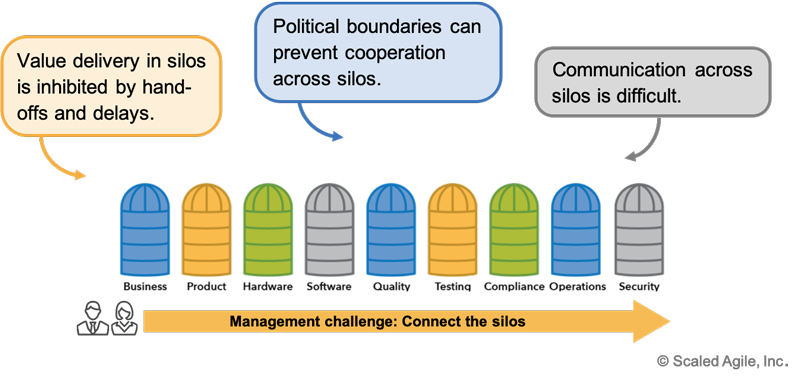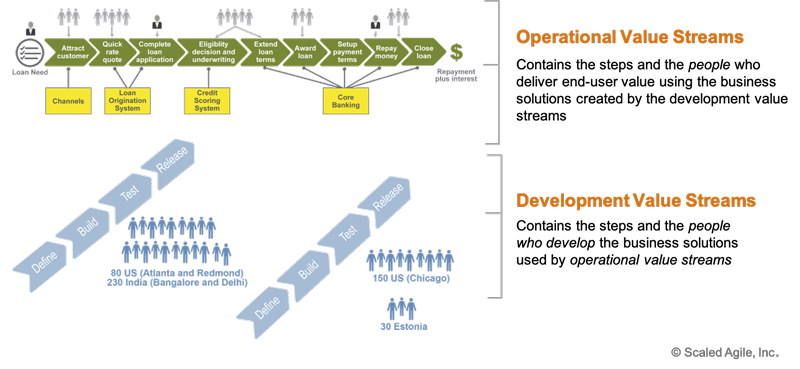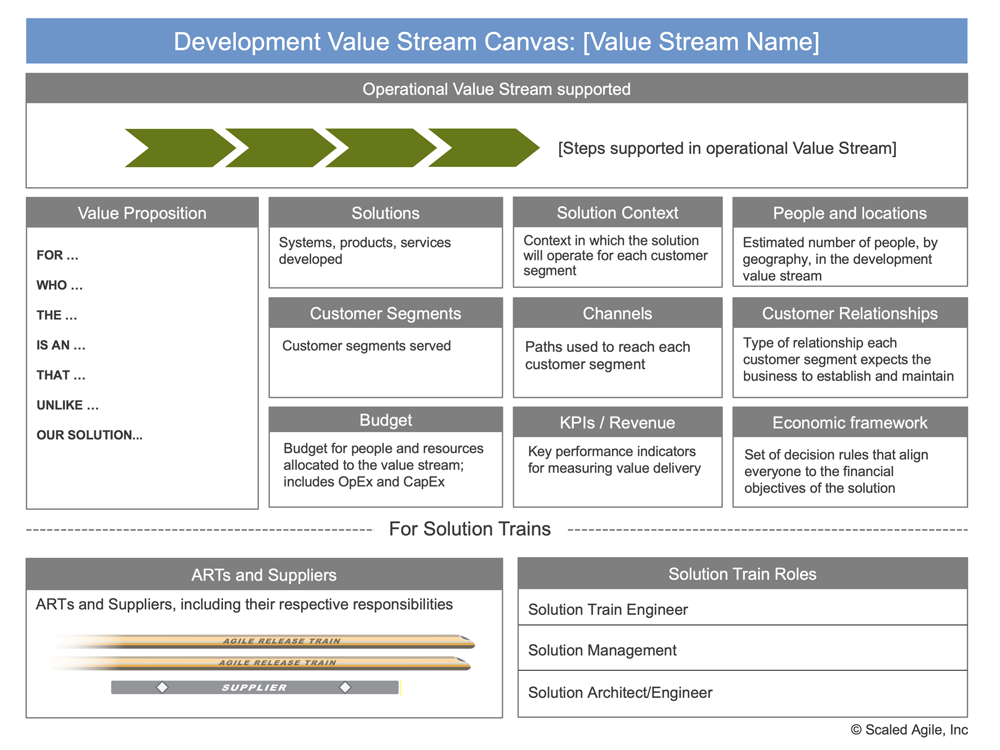Shortest sustainable lead time with the best possible quality and value to people and society.
—House of Lean
Value Streams
Value Streams represent the series of steps that an organization uses to implement Solutions that provide a continuous flow of value to a customer.
A SAFe portfolio contains one or more value streams, each of which is dedicated to build and support a set of solutions, which are the products, services, or systems delivered to the Customer, whether internal or external to the Enterprise.
Details
Prior to the adoption of Lean-Agile practices, many enterprises organize people in functional silos, which causes a number of challenges (Figure 1):
- Value delivery is inhibited by hand-offs and delays
- Adopting Customer-Centricity is problematic because of organizational boundaries
- Systems are designed to optimize the work in silos, not the value delivered

Organizing around value motivates rethinking how solutions are developed and deployed.
Types of Value Streams
A value stream is the primary construct for understanding, organizing, and delivering value in SAFe. Each value stream is a long-lived series of steps used to create value. A trigger starts the flow of value, and there’s some form of monetization or value delivered at the end. The steps in the middle are the activities used to develop or deliver the value.
SAFe defines two types of value streams, as shown in Figure 2.
- Operational value streams – Contains the steps and the people who deliver end-user value using solutions created by the development value streams
- Development value streams – Contains the steps and the people who develop solutions used by operational value streams

Why Organize People in Value Streams?
The reason we organize around value streams is simple. We want to accelerate the time to value (or market). We do that by optimizing the flow of value through the system as a whole. After all, an enterprise that doesn’t have a clear picture of what it delivers and how can’t improve it.
To this end, organizing SAFe portfolios around value streams enables visualizing the flow of work to produce solutions, and it offers the following benefits :
- Fewer handoffs and delays, allowing the teams to work with smaller batch sizes
- Enables long-lived, stable teams that focus on delivering value, instead of projects, which focus on task completion
- Allows faster learning and shorter time-to-market
- Contributes to higher quality and more productivity
- Supports leaner development and budgeting methods
Agile Release Trains (ART) within each value stream develop the business solutions used by the operational value streams. ARTs are cross-functional and have all the capabilities—software, hardware, firmware, and other—needed to define, implement, test, deploy, release, and where applicable, operate solutions.
It’s important to note the value stream construct in SAFe replaces the need to organize people around projects.
Defining Development Value Streams
Defining development value streams and designing ARTs is one of the most critical steps in implementing SAFe and is described in the Identifying Value Streams and ARTs article.
Moreover, once a value stream is identified, additional analysis is required to define the development value stream boundaries, people, deliverables, potential ARTs, and other data. Figure 3 provides a Development Value Stream Canvas, a simple tool that stakeholders can use to capture their emerging understanding [1].

Lean Budgeting for Development Value Streams
Identifying development value streams and understanding the flow through the organization is an essential step in improving value delivery. It also offers the opportunity to implement Lean Budgets, which can substantially reduce overhead and friction and further accelerate flow.
Each development value stream has an approved budget (Figure 4), which Lean Portfolio Management (LPM) manages following Lean-Agile budgeting principles, and over time makes adjustments, based on changing business conditions.

Value Stream KPIs
Each development value stream represents a substantial investment for the enterprise. Therefore it is prudent that there is some reasonable governance applied to evaluate how a value stream is performing against its intended business outcomes. To that end, each value stream defines a set of Key Performance Indicators (KPIs), which can be used to evaluate the ongoing investment in a particular value stream. KPIs are the subject of the Value Stream KPI article.
Value Stream Coordination
Value streams, by design, should be as independent as possible. However, there is likely to be some coordination required to ensure that the enterprise moves forward with each value stream in lockstep with the enterprise and portfolio objectives. Value stream coordination is the entire subject of the Coordination article.
Reducing Time-to-Market with Value Stream Mapping
Finally, there is another significant benefit to identifying the value streams and organizing release trains around them. Each value stream provides an identifiable and measurable flow of value to a customer. As such, it can be systematically measured and improved to increase delivery velocity and quality using value stream mapping—which is an analytical process, teams can use first to understand, and then improve, time-to-market. Using value stream mapping combined with root cause analysis, the maturing Lean enterprise can systematically improve time-to-market aggressively and continuously for its benefit. Reducing delays in the value stream is always the fastest way to reduce time-to-market.
Learn More
[1] Thanks to SAFe Fellow Mark Richards for contributing the Value Stream Canvas concept [2] Martin, Karen, and Mike Osterling. Value Stream Mapping. McGraw Hill, 2014 [3] Poppendieck, Mary, and Tom. Implementing Lean Software Development: From Concept to Cash. Addison-Wesley, 2007 [4] Ward, Allen. Lean Product and Process Development. Lean Enterprise Institute, 2014 [5] https://en.wikipedia.org/wiki/Value-stream_mappingLast update: 30 June 2020





